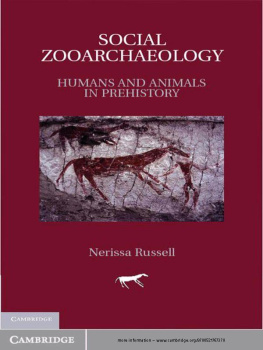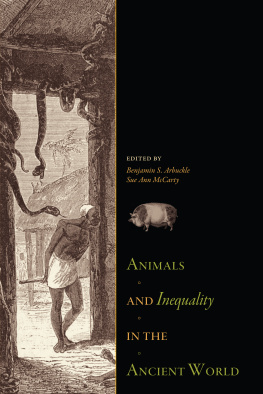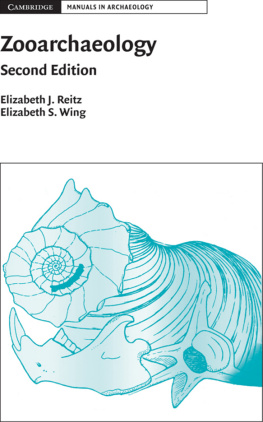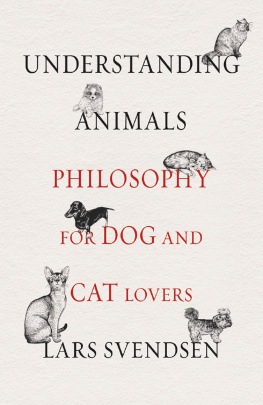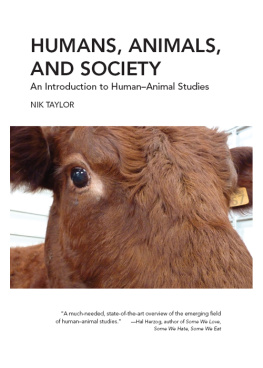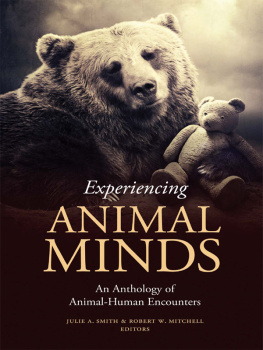Social Zooarchaeology
This is the first book to provide a systematic overview of social zooarchaeology, which takes a holistic view of humananimal relations in the past. Until recently, archaeological analysis of faunal evidence has primarily focused on the role of animals in the human diet and subsistence economy. This book, however, argues that animals have always played many more roles in human societies: as wealth, companions, spirit helpers, sacrificial victims, totems, centerpieces of feasts, objects of taboos, and more. These social factors are as significant as taphonomic processes in shaping animal bone assemblages. Nerissa Russell uses evidence derived not only from zooarchaeology but also from ethnography, history, and classical studies to suggest the range of humananimal relationships and to examine their importance in human society. Through exploring the significance of animals to ancient humans, this book provides a richer picture of past societies.
Nerissa Russell is Associate Professor of Anthropology and Archaeology at Cornell University. Her research focuses on the full range of humananimal relations, with particular emphasis on the social and symbolic roles of animals for ancient people. She has published more than forty book chapters and articles in journals, including Antiquity, Paleorient , and Journal of Archaeological Science .
Social Zooarchaeology
Humans and Animals in Prehistory
Nerissa Russell
Cornell University
CAMBRIDGE UNIVERSITY PRESS
Cambridge, New York, Melbourne, Madrid, Cape Town, Singapore, So Paulo, Delhi, Tokyo, Mexico City
Cambridge University Press
32 Avenue of the Americas, New York , NY 10013-2473, USA
www.cambridge.org
Information on this title: www.cambridge.org/9780521143110
Nerissa Russell 2012
This publication is in copyright. Subject to statutory exception and to the provisions of relevant collective licensing agreements, no reproduction of any part may take place without the written permission of Cambridge University Press.
First published 2012
Printed in the United States of America
A catalog record for this publication is available from the British Library.
Library of Congress Cataloging in Publication data
Russell, Nerissa, 1957
Social zooarchaeology : humans and animals in prehistory / Nerissa Russell.
p. cm.
Includes bibliographical references and index.
ISBN 978-0-521-76737-8 (hardback) ISBN 978-0-521-14311-0 (paperback) 1. Animal remains (Archaeology) 2. Human remains (Archaeology) 3. Social archaeology. 4. Human--animal relationships. I. Title.
CC79.5.A5R87 2012
930.1dc23 2011020299
ISBN 978-0-521-76737-8 Hardback
ISBN 978-0-521-14311-0 Paperback
Cambridge University Press has no responsibility for the persistence or accuracy of URLs for external or third-party Internet Web sites referred to in this publication and does not guarantee that any content on such Web sites is, or will remain, accurate or appropriate.
For Marina and Rafael
Contents
List of tables
Preface
This book has had a long gestation. Its origin lies in a course I taught first as a visiting professor at UCLA some 15 years ago and several times since at Cornell. I had come to feel that zooarchaeology was ignoring many aspects of humananimal relations. In the course I sought to bring ethnography and other disciplines to bear on these issues in a more systematic way than I had begun to do in my research. The first outing of the course convinced me that this material needed to be developed into a book.
At first it seemed like a simple idea to point out the many roles that animals have played in human societies and how they might inform zooarchaeology. Only as I began writing did I realize that this task involved surveying zooarchaeology from around the world and in all periods, as well as the humananimal literature in other disciplines. Therefore, this book has come together slowly, the more so because although when I started there was very little zooarchaeological literature on these topics, as I was writing, what has come to be called social zooarchaeology flowered, eventually to the point where I could not include it all. What began as a cry in the wilderness has become a synthesis of exciting recent work and an attempt to plot a way forward.
Because this book addresses topics and methods, it is not limited in time and space and ranges widely. It is meant to inspire and to lead the reader to the works referenced; I regret that given the breadth of scope I cannot adequately contextualize the archaeological studies in their own localities. I have tried to use dates sparingly and for orientation, so they are generally approximate and given in calibrated years before present (cal BP).
This book has benefited immensely from innumerable conversations through the years. In particular, I would like to thank the students in the various incarnations of the courses Beyond Protein and Calories at UCLA and Humans and Animals at Cornell. These students came from a wide range of backgrounds and have enriched my perspective. I have also profited from discussions with my colleagues at Cornell, particularly in relation to an early draft of presented in a department writing group. Kevin McGowan of the Cornell Laboratory of Ornithology helped me think through evolutionary theory, in addition to being a font of information on everything biological. My many colleagues at atalhyk, notably Louise Martin and Kathy Twiss, have contributed not only to the analysis and interpretation of that assemblage but also to the breadth and depth of my knowledge and thought. I am especially grateful for the most constructive set of comments I received from Jon Driver and two anonymous reviewers. This is a much better book as a result.
Beyond protein and calories
Our starting point is to recognise that subsistence and economy are not synonyms. Subsistence refers to what people live on; economy deals with the management and mobilization of resources. This is true, of course, for all societies at whatever level of organisational complexity and indicates that if we use only palaeoeconomic data to talk of calories and nutrients, an enormous amount of potential information is being ignored. The questions that any research design should address deal with the links between the management of basic resources (plants, animals, raw materials) and people, and with the transformation and maintenance of institutions within the process of social change and reproduction. (Barker and Gamble :5)
Animals have touched the life of every human. Some of us hunt them, some raise them for food and other products, and some keep them as pets. We may take pleasure from watching birds and other wild animals, and we may struggle to keep some animals, such as mice and rats, away from our houses. Many of us eat them, some use their meat or other body parts medicinally, and we make clothing and other products from their skins and fur. Even if we have little direct contact with animals and use no animal products (surely a very rare occurrence), they provide a rich source of symbolism and metaphor: not only food but also food for thought (Gifford-Gonzalez :89).
The social and symbolic importance of animals stems both from their pervasiveness in our lives and from their animate nature (Digard ).

